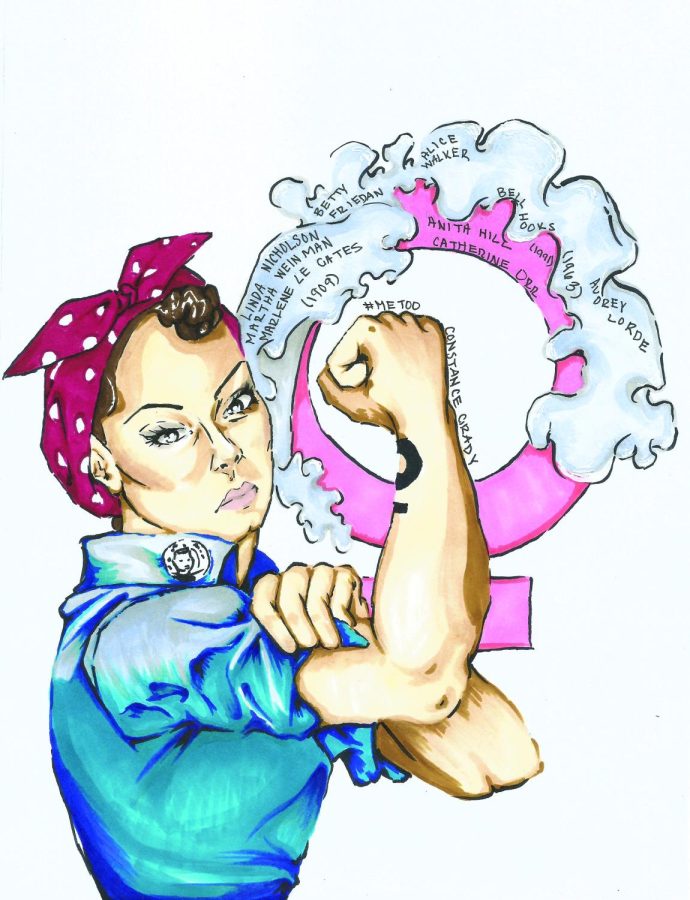Learning to Ride the Wave
March 27, 2023
A brief history of feminism and women-led actions
Born out of an effort to recognize the achievements of women, Women’s History Month is celebrated every March and has roots in feminist actions from the 1970s.
The month first began as a week-long celebration in 1980. According to National Geographic, it drew inspiration from Title IX, a landmark law enacted in 1972 that prohibits sex-based discrimination in any education program that receives federal funding.
The celebration was held to coincide with International Women’s Day on March 8, which holds a place in women’s history after being created by socialist movement leaders in 1909.
Although each event took place at different times, they’ve all been a part of feminist waves, which so far are chronicled through four stages. The term “waves” began being used as a descriptor for feminism in 1968, after a New York Times article by Martha Weinman Lear argued that the fight for women’s rights was a wave of actions rather than independent ones.
Since then, the term waves has been most commonly used to identify feminist eras and generations. Scholars like Linda Nicholson, a professor in women, gender and sexuality studies at Washington University in St. Louis argues that its use is outdated because it implies that gender activism throughout the history of this country has been cohesive, excluding the differences in political actions, goals and groups, especially those from non-white, marginalized communities.
According to Marlene LeGates, author of the book “In Their Time: A History of Feminism in Western Society,” the first wave refers to the 19th and early 20th centuries. Some of the historical moments include the Seneca Falls Convention of 1848, the first birth control clinic to open in the U.S. in 1916 and notably, women’s right to vote in 1920. LeGates notes that this wave includes extreme racism toward Black women, which is historically overlooked.
The second wave began in 1963 after Betty Friedan published “The Feminine Mystique,” which addressed systemic sexism and influenced political actions to come. Achievements during this time were The Equal Pay Act of 1963, Title IX and Roe v. Wade in 1973, which guaranteed the right to have an abortion. Black feminists also branched off and created “womanism” as a response to racism in mainstream feminism, which was mainly targeted at white middle-class women.
Although the start of the third wave of feminism is debated, the term mainly began popping up after Anita Hill’s testimony in 1991, when she testified that then-Supreme Court Nominee Clarence Thomas had sexually harassed her. Catherine Orr, writer of “Charting the Currents of the Third Wave,” characterized this wave as being led by Generation X to fight workplace sexual harassment, increase the number of women in positions of power and address the ways oppression intersects through intersectional feminism. The wave also included a fight for transgender rights, something that the first and second waves lacked.
Similar to how the third wave began, the fourth wave’s beginning is also hard to define. It’s believed to have started in 2012 during the #MeToo movement and was amplified by the Harvey Weinstein scandal. The fourth wave is unique because of its advocacy on the internet and use of technology to drive activism forward. This has led to more inclusive feminist actions when compared to the previous three waves. By utilizing social media, fourth-wave feminists have been able to connect with a broader audience and be a part of international solidarity actions like those in Canada, India and Brazil.
Each wave has had to endure some type of backlash, according to journalist Constance Grady. She says that backlash to fourth-wave feminism’s wins has already begun, with it mainly targeting women’s reproductive rights and financial freedom. It’s marked by the reversal of Roe v. Wade, which in less than a year, has contributed to several states already introducing or passing legislation criminalizing abortion. Grady says it’s also affecting the way women are treated and believed, an example being how Amber Heard was treated during the defamation trial with Johnny Depp.
Though the fourth wave isn’t over, a reflection of each wave’s history serves as a fruitful reminder of the work that still needs to be done.
